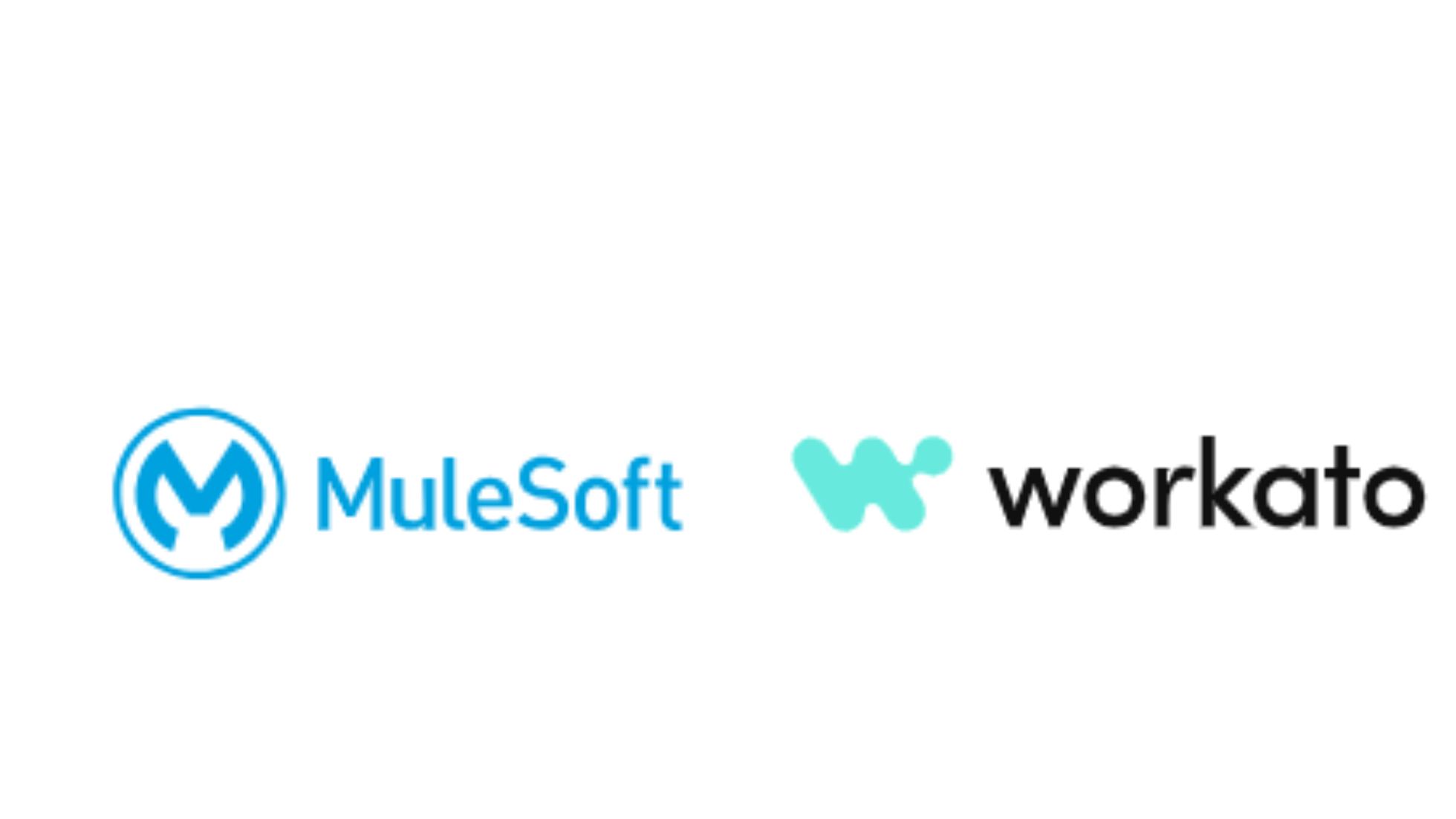 Integration
Integration
4 Key Differences Between Workato vs Mulesoft Integration Platforms
In the fast-paced technology, businesses are constantly seeking ways to streamline their operations and enhance productivity. Two powerful players in the integration game, Workato and Mulesoft, have emerged as go-to solutions for businesses aiming to connect their diverse array of applications seamlessly. In this blog post, we’ll dive deep into the differences between Workato vs Mulesoft, exploring key features, integration capabilities, ease of use, use cases, and the pros and cons of each. Additionally, we’ll provide insights into alternative options for both platforms.
1) Difference between Workato vs Mulesoft Key Features
When it comes to choosing an integration platform, understanding the key features of Workato and Mulesoft is paramount. Workato is renowned for its user-friendly interface, extensive pre-built connectors, and robust automation capabilities. On the other hand, Mulesoft stands out with its advanced API-led connectivity, allowing for more granular control over data flow and manipulation.
Workato: Bridging the Gap with Automation
Workato excels in providing an intuitive platform that doesn’t require a deep technical background. Its key features include:
- Drag-and-Drop Interface: Workato’s user-friendly interface enables users to create workflows effortlessly through a simple drag-and-drop mechanism.
- Pre-built Connectors: Workato boasts a vast library of pre-built connectors, facilitating seamless integration with popular applications like Salesforce, Slack, and more.
- Automation Recipes: The platform offers a rich set of automation recipes, allowing users to automate complex business processes without the need for extensive coding.
Mulesoft: API-Led Connectivity Redefined
Mulesoft takes a more technical approach, emphasizing API-led connectivity and offering advanced features such as:
- Anypoint Platform: Mulesoft’s Anypoint Platform provides a unified integration experience, enabling organizations to connect applications, data, and devices seamlessly.
- API Management: Mulesoft’s robust API management capabilities empower users to design, build, and manage APIs efficiently, ensuring flexibility and scalability.
- DataWeave Transformation: With DataWeave, Mulesoft’s powerful transformation language, users can manipulate data at a granular level, ensuring data consistency across integrated systems.
2) Mulesoft vs Workato Integration Capabilities
The integration capabilities of Workato and Mulesoft play a pivotal role in determining their suitability for different business needs.
Workato: Democratizing Integration
Workato’s integration capabilities are characterized by their accessibility and flexibility:
- Real-time Integration: Workato facilitates real-time integration between applications, ensuring that data is synchronized instantly.
- Hybrid Integration: The platform supports both cloud-based and on-premises applications, providing a hybrid integration approach tailored to diverse business environments.
- Event-Driven Automation: Workato allows users to build event-driven automations, responding to triggers and ensuring a dynamic and responsive integration ecosystem.
Mulesoft: Advanced Integration for Complex Environments
Mulesoft’s integration capabilities are geared towards handling complex integration scenarios:
- API-Led Connectivity: Mulesoft’s API-led approach allows organizations to create reusable APIs, promoting agility and scalability in integration projects.
- Data Integration: Mulesoft’s robust data integration capabilities enable seamless connectivity between disparate systems, ensuring a unified view of data across the organization.
- Multi-Cloud Integration: Mulesoft excels in integrating applications and data across multiple cloud environments, providing a comprehensive solution for businesses with diverse IT landscapes.
3) Workato vs Mulesoft Differences – Ease of Use
One of the critical factors influencing the choice between Workato and Mulesoft is the ease of use, especially for users without extensive technical expertise.
Workato: Democratizing Integration
Workato has positioned itself as a platform that prioritizes ease of use:
- Low-Code Environment: With a low-code environment, Workato allows users to create sophisticated integrations without delving into complex coding.
- Intuitive Interface: The platform’s intuitive interface makes it easy for users to navigate and build workflows, minimizing the learning curve for beginners.
- Community Support: Workato’s vibrant community provides ample resources, tutorials, and support, empowering users to overcome challenges and explore advanced features.
Mulesoft: Technical Prowess at a Cost
Mulesoft, while powerful, requires a more technical skill set:
- Learning Curve: Mulesoft’s advanced features and technical depth contribute to a steeper learning curve, making it better suited for users with a strong technical background.
- Developer-Centric: The platform caters more towards developers, offering extensive customization options but requiring a deeper understanding of integration concepts.
- Professional Services: Mulesoft often necessitates professional services for optimal implementation, adding to the overall cost of adoption.
4) Use Cases
Understanding the specific use cases where Workato and Mulesoft shine can guide businesses in making the right choice for their integration needs.
Workato: Agile Integration for Diverse Scenarios
Workato is well-suited for a range of use cases, including:
- E-commerce Integration: Workato’s real-time integration capabilities make it ideal for e-commerce businesses, ensuring seamless connectivity between online stores, payment gateways, and inventory systems.
- Sales and Marketing Automation: With its extensive library of connectors, Workato enables organizations to automate sales and marketing processes, improving efficiency and data accuracy.
- HR Process Automation: Workato’s low-code environment makes it accessible for HR professionals to automate onboarding, employee management, and other HR processes without extensive technical expertise.
Mulesoft: Enterprise-Grade Integration for Complex Environments
Mulesoft excels in addressing complex integration scenarios typical in large enterprises:
- Enterprise Resource Planning (ERP) Integration: Mulesoft’s advanced capabilities are well-suited for integrating diverse ERP systems, ensuring seamless data flow across the organization.
- Healthcare Integration: In the healthcare sector, Mulesoft’s ability to handle intricate data exchange between electronic health record (EHR) systems, billing systems, and other applications is invaluable.
- Financial Services Integration: Mulesoft’s robust security features make it a preferred choice for the financial services sector, where secure and compliant data integration is paramount.
Pros and Cons of Workato and Mulesoft
Before making a decision, it’s crucial to weigh the pros and cons of each platform to ensure alignment with specific business requirements.
Workato
Pros:
- User-Friendly: Workato’s low-code environment makes it accessible to users with varying technical backgrounds.
- Extensive Connector Library: The platform’s vast library of pre-built connectors simplifies integration with a wide range of applications.
- Real-Time Integration: Workato excels in providing real-time integration capabilities, ensuring data synchronization on the fly.
Cons:
- Limited Complexity: While suitable for many scenarios, Workato may face limitations when handling highly complex integration requirements.
- Scalability Concerns: Businesses with extensive scalability needs may find Workato less suitable for large-scale projects.
Mulesoft
Pros:
- Advanced Integration: Mulesoft’s API-led connectivity and advanced features make it a powerhouse for handling complex integration scenarios.
- Robust Security: In industries where data security is paramount, Mulesoft’s robust security features stand out.
- Enterprise-Grade Scalability: Mulesoft is well-suited for large enterprises with extensive scalability requirements.
Cons:
- Steep Learning Curve: The advanced nature of Mulesoft’s features results in a steeper learning curve, requiring users with a strong technical background.
- Higher Cost of Implementation: Mulesoft often requires professional services for optimal implementation, contributing to higher overall costs.
6 Workato Alternatives
While Workato is a robust integration platform, exploring alternatives can provide a more comprehensive understanding of available options.
- Zapier: Known for its simplicity, Zapier is a user-friendly automation tool suitable for small to medium-sized businesses.
- Integromat: Offering advanced automation capabilities, Integromat provides a visual approach to building complex workflows.
- Tray.io: Tray.io focuses on empowering business users with a low-code integration platform that supports complex workflows.
- Jitterbit: Jitterbit is an integration platform that caters to both technical and non-technical users, supporting a wide range of integration scenarios.
- SnapLogic: With a focus on self-service integration, SnapLogic allows users to connect applications and data sources without extensive coding.
- Talend: Talend provides a comprehensive open-source integration platform, offering both data integration and API management capabilities.
6 Mulesoft Alternatives
For businesses considering alternatives to Mulesoft, exploring other options can uncover the most suitable solution for their integration needs.
- Dell Boomi: Boomi provides a cloud-native integration platform with a focus on simplicity and speed.
- Apache Camel: As an open-source integration framework, Apache Camel allows users to create robust integration solutions using a variety of technologies.
- WSO2: WSO2 offers an open-source integration platform with API management and analytics capabilities.
- Liquibase: Focused on database schema version control, Liquibase simplifies database changes and versioning.
- IBM Integration Bus: IBM’s integration bus is designed for enterprises with complex integration requirements, providing a comprehensive set of tools.
- TIBCO BusinessWorks: TIBCO’s BusinessWorks is an integration platform known for its speed and flexibility in connecting disparate systems.
Workato vs Mulesoft – FAQs
Is Workato suitable for large enterprises with complex integration needs?
Workato is generally well-suited for a wide range of businesses, including large enterprises. However, businesses with extremely complex integration requirements may find Mulesoft more tailored to their needs.
Can Mulesoft handle real-time integration like Workato?
Yes, Mulesoft can handle real-time integration. Its advanced capabilities and API-led approach allow for real-time data synchronization across connected systems.
What are the key considerations when choosing between Workato and Mulesoft?
Key considerations include the complexity of integration requirements, the technical expertise of users, scalability needs, and budget constraints. Workato is often favored for its user-friendly approach, while Mulesoft excels in complex enterprise environments.
Are there any open-source alternatives to Workato and Mulesoft?
Yes, there are open-source alternatives available. Apache Camel, Talend, and WSO2 are examples of open-source integration platforms that offer flexibility and customization options.
How does the cost of implementation compare between Workato and Mulesoft?
Workato generally has a lower cost of implementation due to its user-friendly, low-code environment. Workato vs Mulesoft , with its advanced features, may require professional services, contributing to higher implementation costs.
Relevant Guides
Monday.com Salesforce Integration
View All Posts








